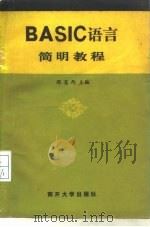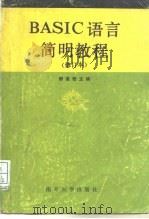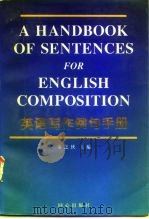《简明英语语言学教程》
| 作者 | 戴炜栋,何兆熊,华钧编 编者 |
|---|---|
| 出版 | 未查询到或未知 |
| 参考页数 | 167 |
| 出版时间 | 1984(求助前请核对) 目录预览 |
| ISBN号 | 无 — 求助条款 |
| PDF编号 | 815108008(仅供预览,未存储实际文件) |
| 求助格式 | 扫描PDF(若分多册发行,每次仅能受理1册) |

Ⅰ.Introduction1
1.Linguistics1
1.1 What is linguistics?1
1.2 Linguistics vs.traditional grammar1
1.3 The scope of linguistics3
2.Language6
2.1 What is language?6
2.2 The defining properties of human languages6
Ⅱ.Phonology11
1.The phonic medium of language11
2.Phonetics11
2.1 What is phonetics?11
2.2 The speech organs12
2.3 Orthographic represention of speech sounds—narrow and broad trans?iptions13
2.4 Somo major articulatory ?ariahles14
2.5 Classification of English speech sounds15
3.Phonology18
3.1 Phonetics and phonology18
3.2 Phone,phoneme and allphone19
3.3 Phonemic contrast,comp? distribution and minimal pair20
3.4 Sequences of phonemes21
3.5 Some rules of phonology22
3.6 Suprasegmental features—stress,tone,intonation23
Ⅲ.Morphology27
1.Morphology27
1.1 Open classes and closed classes27
1.2 Internal structure of Words and rules for word for-mation28
2.Morphemes—the minimal uhits of meaning29
3.Derivational and inflectional morphemes30
4.Morphological rules of word formation32
5.Compunds33
Ⅳ.Syntax37
1.Syntax37
1.1 What is syntax?37
1.2 Sentence37
2.Stuctralist approach37
2.1 Form classes38
2.2 Constituent structure40
2.3 Immediate consti?nent analysis40
2.4 Endooentric and exocentric consructions42
2.5 Advantage of IC analysis43
2.6 Labelled tree diagram44
2.7 Discontinuous constituents45
3.Transformational-generative grammar46
3.1 Competence and performance46
3.2 C?iteria for judging grammars47
3.3 Generative aspect48
3.4 Transformational aspect48
3.5 Deep and surface structures49
4.The Standard Theory51
4.1 Components of a TG51
4.2 The base52
4.3 Transformations55
4.4 The form of T-rules57
4.5 The phonological component58
4.6 The semantic component59
Ⅴ.Semantics62
1.Semantics62
1.1 What is semantics?62
2.Some views on semantics62
2.1 Naming things63
2.2 Concepts63
2.3 Context and behaviourism64
2.4 Mentalism65
3.Lexical structure67
3.1 Sense and reference67
3.2 Synonymy69
3.3 Polysemy and homonymy71
3.4 Hyponymy72
3.5 Antonymy73
3.6 Relational opposites74
4.Componential analysis74
4.1 Components of meaning74
4.2 Meaning relations76
5.Sentence meaning78
5.1 How to define the meaning of a sentence?78
5.2 Selectional restrictions79
5.3 Basic statements about meaning81
6.The semantic structure of sentences82
6.1 Extended use of componential analysis82
6.2 Predication analysis84
6.3 Subordinate and downgraded predications86
6.4 Advantages of predication analysis88
7.Context and meaning91
7.1 Malinowski's view91
7.2 Firth's view92
7.3 Utterance meaning93
Ⅵ.Language change97
1.Introduction97
2.Sound change97
3.Morphological and syntactic change98
3.1 Change in"agreement"rule98
3.2 Change in negation rule98
3.3 Process of simplification99
3.4 Change in inflections99
4.Vocabulary change100
4.1 The addition of new words100
4.2 The loss of words103
4.3 Change in the meanings of words104
5.Some recent trends105
5.1 Moving towards greater informality105
5.2 The influence of American English106
5.3 The influence of science and technology106
Ⅶ.Some topics in sociolinguistics110
1.The scope of sociolinguistics110
1.1 Sociolinguistics vs.traditional linguistic studies110
1.2 Indications of relatedness between language and society111
1.3 Two approaches in sociolinguistics112
2.The sociology of language113
2.1 The definition of a language113
2.2 Functional language types114
2.3 Social differentiation and language117
2.4 Bilingualism and diglossia—two specific socio-linguistic situations121
3.Sociolinguistics proper124
3.1 Speech event124
3.2 Speech functions125
3.3 Communicative competence128
3.4 Language variation129
Ⅷ.Language acquisition136
1.Introduction136
1.1 Language acquisition136
1.2 The beginning of language136
1.3 Stages in first language acquisition136
1.4 Age and native language acquisition137
1.5 Common order in the development of language138
1.6 Different rate of language development138
2.Phonological development139
2.1 Regular sound development139
2.2 Mother and father words139
2.3 Grammatical development140
2.4 Vocabulary development141
2.5 Sociolinguistic development142
Ⅸ.Error analysis and second language acquisition146
1.Diffrences and similarities between first and second language acquisition146
2.The inadequacy of imitation theory147
3.Interference148
3.1 Phonological evidence148
3.2 Lexical evidence149
3.3 Grammatical evidence149
4.Cross-association150
5.Overgeneralization151
6.Strategies of communication152
7.Performance errors153
Appendix156
Ⅰ Bibliography156
Ⅱ.A Glossary In English And Chinese160
1984《简明英语语言学教程》由于是年代较久的资料都绝版了,几乎不可能购买到实物。如果大家为了学习确实需要,可向博主求助其电子版PDF文件。对合法合规的求助,我会当即受理并将下载地址发送给你。
高度相关资料
-

- 英语语音简明教程
- 1960 北京:商务印书馆
-

- 语言简明教程
- 1984.12 南开大学出版社
-

- 简明英语语音教程
- 河南理工大学外语系
-

- 简明英语语言学教程
- 1984
-

- 简明大学英语语法教程
- 1997 昆明:云南科学技术出版社
-

- C语言简明教程
- 1996 北京:电子工业出版社
-

- C语言简明教程
- 1994 上海:上海科学普及出版社
-

- IBM PC C语言简明教程
- 1988 天津:天津科学技术出版社
-

- BASIC语言简明教程
- 1984 天津:南开大学出版社
-

- BASIC语言简明教程
- 1989 天津:南开大学出版社
-

- Ada语言简明教程
- 1985 北京:北京航空学院出版社
-

- 英语写作例句手册
- 1997 北京:同心出版社
-

- C语言程序设计简明教程
- 1987 南京工学院出版社
-

- 简明经济学英语教程
- 1999 北京:中国金融出版社
-

- 英语语音简明教程
- 1973 北京:商务印书馆
提示:百度云已更名为百度网盘(百度盘),天翼云盘、微盘下载地址……暂未提供。➥ PDF文字可复制化或转WORD